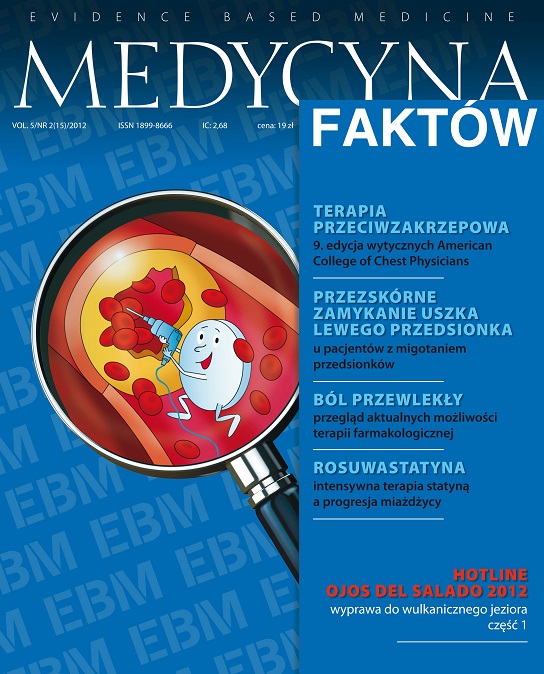Przezskórne zamykanie uszka lewego przedsionka jako nowa metoda ograniczania ryzyka udaru mózgu u pacjentów z migotaniem przedsionków Artykuł przeglądowy
##plugins.themes.bootstrap3.article.main##
Abstrakt
Migotanie przedsionków jest jedną z najczęściej występujących arytmii. Jednym z głównych celów leczenia migotania przedsionków jest zapobieżenie powikłaniom zatorowym. Obecnie przewlekła terapia antagonistami witaminy K lub nowymi lekami przeciwzakrzepowymi pozostaje najlepszą metodą zapobiegania udarowi mózgu. Jednak blisko 20% chorych z migotaniem przedsionków wymagających stosowania antykoagulantów ma przeciwwskazania do tego rodzaju leczenia. Wiadomo, że w grupie chorych z niezastawkowym migotaniem przedsionków miejscem najczęstszego tworzenia się skrzeplin jest uszko lewego przedsionka. Zastosowanie przezskórnych systemów zamykających uszko lewego przedsionka wydaje się obiecującym rozwiązaniem dla chorych z przeciwwskazaniami do przewlekłej terapii lekami przeciwzakrzepowymi.
##plugins.themes.bootstrap3.article.details##
Copyright © by Medical Education. All rights reserved.
Bibliografia
2. Stroke Prevention In Atrial Fibrillation Study. Final Results. Circulation 1991; 84: 527-39.
3. Connolly S.J., Laupacis A., Gesnt M. et al.: Canadian Atrial Fibrillation Anticoagulation (CAFA) Study. JACC 1991; 18: 349-55.
4. Cooper N.J., Sutton A.J., Lu G. et al.: Mixed comparison of stroke prevention treatments in individuals with nonrheumatic atrial fibrillation. Arch. Intern. Med. 2006; 166: 1269-75.
5. Van Walraven C., Jennings A., Oake N. et al.: Effect of study settings on anticoagulation control: a systemic review and metaregression. Chest 2006; 129: 1155-66.
6. Connolly S.J., Ezekowitz M.D., Yusuf S. et al.: Dabigatran versus warfarin in patients with atrial fibrillation. NEJM 2009; 361: 1139-51.
7. Patel M.R., Mahaffey K.W., Garg J. et al.: Rivaroxaban versus warfarin in nonvalvular atrial fibrillation. NEJM 2011; 365: 883-891.
8. Granger C.B., Alexander J.H., McMurray J.J. et al.: Apixaban versus warfarin in patients with atrial fibrillation. NEJM 2011; 365: 981-992.
9. Gottlieb L.K., Salem-Schatz S.: Anticoagulation in atrial fibrillation. Does efficacy in clinical trials translate into effectiveness in practice. Arch. Intern. Med. 1994; 154: 1945-53.
10. The Stroke Prevention In Atrial Fibrillation Investigator Committee on Echocardiography. Transesophageal echocardiography correlates of thromboembolism in high-risk patients with nonvalvular atrial fibrillation. Ann. Intern. Med. 1998; 128: 639-647.
11. 2008 Focused update incorporated into the ACC/AHA guidelines for the management of patients with valvular heart disease: a report of the ACC/AHA Task Force on Practice Guidelines. Circulation 2008; 118: 523-661.
12. Cox J.L.: The surgical treatment of atrial fibrillation. J. Thorac. Cardiovasc. Surg. 1991; 101: 584-592.
13. Ostermayer S.H., Reisman M., Kramer P.H. et al.: Percutaneous left atrial appendage transcatheter occlusion (PLATOO system) to prevent stroke in high-risk patients with non-rheumatic atrial fibrillation. Results from the international multicenter feasibility trials. JACC 2005; 111: 9-14.
14. Block P.C., Burstein S., Casale P.N. et al.: Percutaneous left atrial appendage occlusion for patients in atrial fibrillation suboptimal for warfarin therapy – 5-year results of the PLATOO Study. JACC Cardiovasc. Interv. 2009; 2: 594-600.
15. Holmes D.R., Reddy V.Y., Turi Z.G. et al.: Percutaneous closure of the left atrial appendage versus warfarin therapy for prevention of stroke in patients with atrial fibrillation: a randomized non-inferiority trial. Lancet 2009; 374: 534-542.
16. Reddy V.Y., Holmes D.R., Doshi S.K. et al.: Safety of percutaneous left atrial appendage closure: results from Watchman Left Atrial Appendage System for Embolic Protection In Patients With AF (Protect AF) clinical trial and the Continued Access Registry. Circulation 2011; 123: 417-24.
17. Park J.W., Bethencourt A., Sievert H. et al.: Left atrial appendage closure with Amplazer cardiac plug in atrial fibrillation: initial European experience. Catheter. Cardiovasc. Interv. 2011; 77: 700-706.
